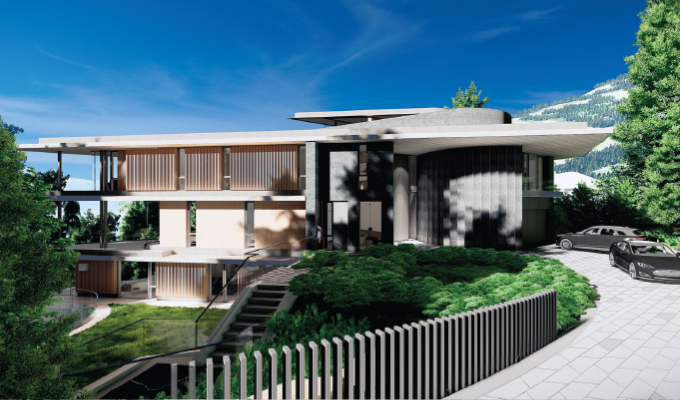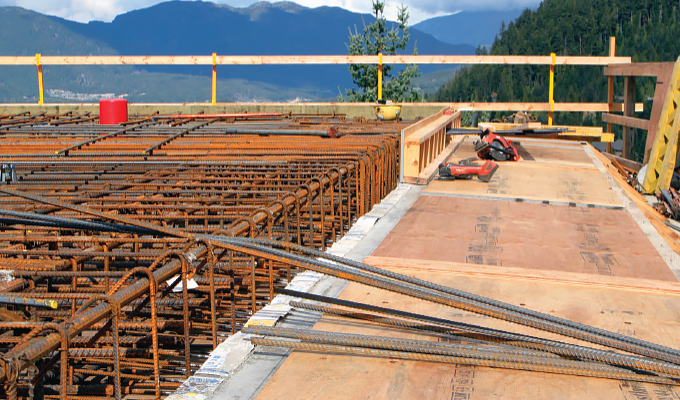Perched on the hillside of Whistler Mountain—one of North America’s top ski resorts—the 20,000-square-foot Kadenwood residence complies with stringent energy efficiency and seismic requirements. Its footprint is a four-sided polygon with sweeping views of coastal mountains and alpine lakes.
The four storey ski-in/ski-out structure features an elevator that transports occupants from the entry level to the ski slopes 50 feet below. The top three stories have year-round accommodations for the homeowners and separate suites for three other families.
The building is a study in concrete cantilevers reminiscent of Frank Lloyd Wright’s Falling Water, whose cantilevers appear to float above a waterfall.
“We wanted to cantilever the top two floors over the ski slopes and toward the views, so that when in the house you felt you were floating in the clouds,” explains senior technologist Eric Pettit of the Vancouver, B.C. architecture firm Openspace.
When Kadenwood construction began, he says that building codes in Canada encouraged the use of structural thermal breaks to mitigate thermal bridging, and with the current BC Energy Step Code, the building would have to include them to meet the high energy performance target.
TRANSFERRING LOADS, NOT HEAT
Cantilevers impart high rotational and shear forces, especially in the mountains of Western Canada due to the district’s snow loads of 176 psf, compared to design loads of 34.3 psf in low-lying Vancouver, which is 125 miles to the south. The designers needed cantilevered structures that could not only carry those loads, but also meet seismic requirements of the region.
“The whole structure is concrete—from the basement to the roof,” says concrete contractor Graham Roberge of Alpen Construction, subcontractor of Bradner Homes Ltd. “We used about 2,616 cubic yards of concrete and a million pounds of (reinforcing) steel on the project.”
Given the high thermal conductivity of concrete and steel, and its high surface area exposed to Whistler’s frigid winter temperatures, the design team needed to mitigate thermal bridging and its unwanted effects.
STRUCTURAL THERMAL BREAKS
To prevent thermal bridging while supporting cantilever loads, the designers specified four types of structural thermal breaks. For the balcony and roof elements, the team specified Schöck Isokorb® concrete-to-concrete modules. Each 3.3 foot module consists of a block of rigid insulation penetrated by stainless steel rebar, which ties into the rebar of the interior slab and the cantilevered balcony. The insulation separating the interior and exterior slabs, together with stainless steel rebar that is one-third as conductive as carbon steel rebar, reduces heat loss at the penetration by up to 90 percent, according to the manufacturer. These modules are interspersed with a different kind of Isokorb concrete-to-concrete thermal break modules that transfer horizontal earthquake forces as required in the region.
Above several windows the architects incorporated concrete “brows” that overhang a short distance similar to a sunshade. For these small cantilevers, the design team specified Isokorb concrete-to-concrete thermal breaks for slab edges. The stainless steel rebar penetrating the insulation block ties into the interior slab rebar. On the exterior side, the rebar forms into a loop to support the small cantilever.
The fourth Isokorb thermal break used connects concrete to steel at the steel balcony that cantilevers from the concrete structure over the entry area. The stainless steel rebar on the interior side of the module is wired into the floor slab rebar. Once cast in concrete, the exterior threaded side of each rod is bolted to steel balcony beams using backing plates and high strength stainless steel nuts.
Roberge estimates his crew installed about 1,000 linear feet of concrete-to-concrete thermal breaks and 30 concrete-to-steel thermal breaks.

PREVENTING CONDENSATION, MOLD
Increasing the temperature of structural penetrations on the interior side of the insulated envelope also prevents condensation and mold growth. Pettit explains: “Because of the thickness of the slab and the sheer volume of cold material connected to warm material, there’s a threat of icing and frosting inside the building. The structural thermal breaks improve envelope performance in those areas.”
While the alpine climate on Whistler Mountain averages a nippy 7 to 19°F in mid-winter, temperatures also fluctuate dramatically year-round due to the region’s proximity to the temperate coastal region, exacerbating problems of condensation and mold. “Whistler isn’t like Alberta where everything freezes until spring. There is a constant freeze/thaw cycle,” Pettit says. “Humidity in the house can start to condense on the cold surfaces and cause problems.”
CLOSING THOUGHT
Openspace began specifying structural thermal breaks in 2014 when designing another Whistler Mountain project. “On that building, we were trying to figure out how to hang heavy concrete cantilevers by designing our own bolt-on details. When we happened upon the Isokorb products, I was excited,” Pettit says. “They were the perfect solution to the problem.”
for more information
For more about Schöck North America’s structural thermal breaks, visit www.schock-na.com.
Modern Contractor Solutions, January 2021
Did you enjoy this article?
Subscribe to the FREE Digital Edition of Modern Contractor Solutions magazine.



